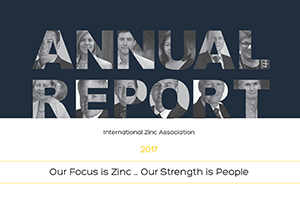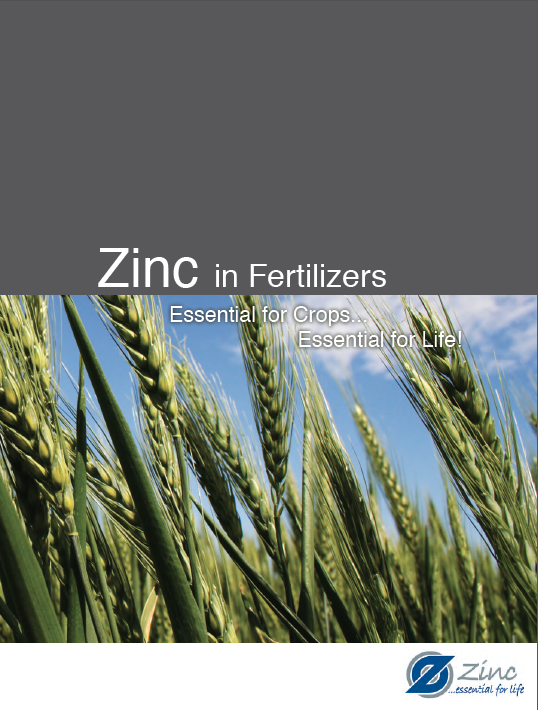Publications
[accordion]
[toggle title=”General Publications” state=”opened”]
 |
Making a Difference: 20 Years of Service to the World Zinc Industry This publication describes IZA’s remarkable journey over the last twenty years, its key achievements and the new issues barely visible 20 years ago that will shape its future. Throughout its history, IZA has remained true to its strategy of working to enhance zinc’s image, markets and contribution to sustainable development. To read online, click here. To download, click here: IZA_20th_Anniversary_Brochure. |
 |
IZA 2017 Annual Report This publication covers highlights of IZA’s program activities during 2017.To download, click here: IZA 2017 Annual Report. |
[/toggle]
[toggle title=”Zinc Applications”]
 |
Continuous Galvanized Rebar: An Introduction This brochure describes the process of continuously galvanizing rebar and features its unique advantages including coating adhesion, corrosion resistance, ease of coating and cost savings.To download, click here: CGR Brochure. |
 |
Hot Dip Galvanizing in Mining This publication covers galvanized components in surface projects, underground mines, conveyors and marine terminals. Also included are over 20 case studies of general galvanized structural components used in mines throughout the world. To read online, click here. To download, click here: Hot Dip Galv in Mining Brochure. |
 |
Ultra Thin Zinc Die Casting Alloys This publication presents the main characteristics of the recently developed High Fluidity (HF) Alloy that is based on the traditional Zamak composition and the earlier developed copper-rich alloy marketed under the names of Superloy and GDSL. Both compositions allow for thin section casting and have the potential of entering new markets. To read online, click here. To download, click here: IZA Ultra Thin Alloy Brochure, Final. |
 |
The New High Fluidity Zinc Alloy This brochure was created on behalf of the U.S. Department of Energy and the North American Die Casting Association to illustrate the properties of a new high fluidity zinc alloy. To download, click here: DoE_High_Fluidity_Alloy_Brochure_final. |
 |
A Performance Evaluation of Traditional and Green Surface Finishes for Zinc Die Castings This 12–page publication provides the performance results of a series of new surface finishes using best practice green technology that were tested in two categories – corrosion protection and aesthetic retention – and compares them to the results of an earlier study conducted with traditional surface finishes. To download, click here: Traditional and Green Finishes in Die Casting |
[/toggle]
[toggle title=”Health”]
 |
Zinc Saves Kids: Making a Difference to Child Health and Survival This brochure describes the critical problem of zinc deficiency and IZA’s partnership with UNICEF called Zinc Saves Kids. The goal of this initiative is to increase awareness of global zinc deficiency and raise funds to support UNICEF’s zinc supplementation and treatment programs to improve the survival, growth, and development of undernourished children. To read the English version online, click here. To download the English version, click here: ZSK Brochure |
 |
What is one of the most essential elements vital to our health? Surprisingly it’s zinc! Zinc is one of nature’s most vital, essential elements. Humans, animals, plants and even the smallest micro-organisms need zinc to function (this accordion-style brochure is also available in other languages on request). To download this brochure, click here: Essential_Element_Trifold. |
[/toggle]
[toggle title=”Fertilizers”]
 |
Zinc in Fertilizers: Essential for Crops; Essential for Life A brochure highlighting the importance of zinc fertilizers in correcting zinc deficiency in soils and crops with the objective of increasing crop quality and yield and getting more zinc into people’s diets. It is estimated that one third of the world’s population is zinc deficient, resulting in numerous health problems including poor immune response which may lead to high mortality rates especially among small children. For millions of people a few extra milligrams of zinc each day can make a difference between illness or death and a healthy, productive life. To read online, click here. To download, click here: Zinc In Fertilizers Brochure. |
 |
Zinc in Soils and Crop Nutrition by Brian Alloway, Emeritus Professor of Soil Science, University of Reading, U.K. 2nd edition 2008. Zinc is needed by plants in small but critical concentrations for a wide range of physiological processes. Zinc deficiency causes reduced yields, impaired quality and increased susceptibility to disease. Zinc deficiency is the most widespread of all micronutrient problems in crops. The current report puts the problem in a geographical and agronomic context and deals with the economic and humanitarian consequences of lost yields due to vast areas, amounting to millions of hectares of crops, being affected by zinc deficiency. To download this book, click here: Zinc in Soils Book |
[/toggle]
[toggle title=”Sustainability and Recycling”]
 |
Zinc: A Sustainable Material, Essential for Modern Life Increasingly the zinc industry is being asked to provide information to downstream users of zinc and zinc containing products on the environmental footprint of the materials it produces. Material specifiers and product engineers in key end use markets, such as building, construction and transportation, are more and more interested in selecting materials that have the best environmental profile while meeting traditional cost, quality and technical performance criteria. To download, click here: Zinc: A Sustainable Material, Essential for Modern Life |
 |
Zinc Environmental Profile – Life Cycle Assessment – 2015 Update Understanding the environmental footprint of zinc starts with documenting the resource requirements (energy and non-energy) and environmental releases associated with zinc mining and refining, but it also involves understanding the impacts and the benefits of using zinc during other stages in the product life cycle. These benefits can arise in use (extending the life of galvanized steel products) and through end-of-life recycling (by utilizing recycled zinc to create new products). This environmental profile was developed to provide updated information from the original Zinc Environmental Profile published in 2010 and life cycle data on primary zinc to stakeholders along the zinc value chain. To download this publication, click here. |
 |
Zinc Sheet Environmental Profile – Life Cycle Assessment Zinc sheet has a number of attributes that make it desirable for use in a range of applications. It is durable; it is 100% recyclable, and for major applications such as roofing and wall claddings, the recycling rate reaches 95%. This high recycling rate significantly reduces the impacts of the production of the zinc used in zinc sheet. Zinc is also aesthetically pleasing, which means it is less likely to be replaced before needed. To download this publication, click here. |
 |
Zinc Recycling: Closing the Loop This publication describes the recycling circuit for zinc, including: sources for recycled zinc, ends uses, methods for assessing recycling rates, and current recycling statistics. To download this publication, click here. |
 |
Zinc Recycling: Material Supply This fact sheet explains the material supply for zinc metal, including how much zinc is currently in use, how much is in production, how much of the zinc in use is recycled, and estimates of world zinc reserves. To download this publication, click here. |
 |
Zinc Recycling: In Use Stocks This fact sheet explains the concept of in-use stocks, how they compare to geologic stocks, how they have evolved over time, and what current trends can tell us about future use. To download this publication, click here. |
 |
Zinc Recycling: In Use Stocks This fact sheet explains the stocks and flows of zinc on a global basis, providing a description of material flow analysis and brief examination of the zinc life cycle.To download this publication, click here. |
[/toggle]
[toggle title=”Environment”]
 |
Zinc in the Environment: Understanding the Science Due to its unique properties, zinc is used in a wide range of consumer, infrastructure, agricultural, and industrial products. More importantly, zinc is essential to life, playing an important role in biological processes of all living organisms (humans, animals, and plants). The intent of this document is to describe the many interactions that occur between zinc and the environment in which it resides. To read this brochure online, click here. To download, click here: Zinc in the Environment – Understanding the Science. |
[/toggle]
[/accordion]
